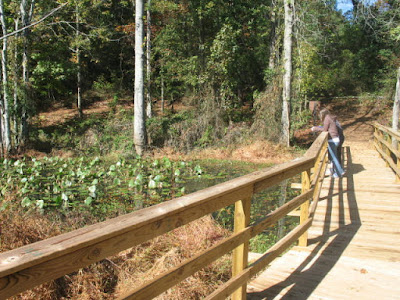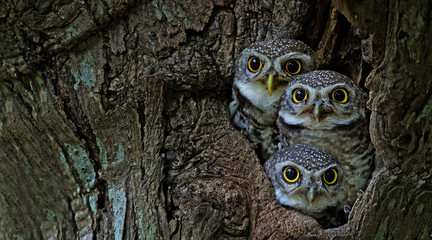Located south of the city of Greenville, just off Mauldin
Road, is one of the hidden jewels of Greenville County. Lake Conestee Nature Park
(LCNP) is a 400+ acre nature preserve owned by the Conestee Foundation and
operated by the Greenville County Recreation District.
The park itself was opened in 2006, but the
area included in the park has a long history of influence in the development of
Greenville County. The Conestee area (pronounced CON-es-tee) grew up around the Reedy River. The first property owners were likely Revolutionary War patriots and soldiers rewarded with deeds to land in the area. The properties changed hands multiple times over the next 100 years, but the Reedy River and its shoals continued to provide power for the mill and manufacturing businesses located on the river.
 |
| Reedy River at Lake Conestee Nature Park 2007 |
By 1820, the
village of Conestee had formed around the mill located there. The date the first dam was built on the Reedy
River is unknown, but by 1892, the demand for power had grown and the rock dam
was raised to its present height, creating the 130 acre Lake Conestee.
 |
| Lake Conestee, 2007 |
In 1890, only two mills were located in the
area. By 1915, twelve mills were
operating, and all the mills were discharging sewage and industrial
contaminants into the Reedy River. The
city of Greenville and other industries also discharged raw sewage and
manufacturing waste into the Reedy. All
of this waste found its way to Lake Conestee.
The water in the lake could not be used for anything, except to power
the mill.
 |
| Lake Canestee Nature Park Trails 2007 |
By 1925, the buildup of
pollution led Conestee Mill to sue the city of Greenville for damages suffered
by the mill and the employees of the mill caused by the pollution of the Reedy
River. The lawsuit was not settled until
1931. Conestee Mill was failing by then,
due to the Great Depression and the effects of the lawsuit, so the settlement
did not benefit the mill. The lawsuit
did, however, benefit the area by providing the push to clean up the pollution
in the Reedy. The LCNP website has an
excellent and very detailed review of the history of this area.
 |
| Lee and kids |
Since 1892, the size of the original 130 acre Lake Conestee
has gradually decreased to 20 acres. How
did that happen? Sediments and soils
from area development, including the construction of I-85, have filled in about
90% of the lake. The area is now mostly shallow wetlands. The former lake bed has been capped with
bottom land forests. The contaminants from the lake’s early days as a collector
of industrial waste and sewage remain in the lake bed under the cap and are
managed as a Brownfield site by the Conestee Foundation through a voluntary
cleanup contract with South Carolina Department of Health and Environmental
Control (SCDHEC).
Passive recreation
activities, such as walking and biking, do not pose a significant health risk,
based on assessments by SCDHEC and the EPA.
The long-term plan for management is to keep the sediments in place and
undisturbed and to keep the dam in excellent condition. The transformation of the property from an
area loaded with noxious chemicals to its present status as a wildlife
sanctuary and community asset was spearheaded by the Conestee Foundation and
its executive director, Dave Hargett, Ph.D.
In fact, in December of 2017, the LCNP was recognized as 1st
runner-up for the Phoenix award, a national award given by the EPA for
excellence in reuse or redevelopment of brownfield areas! And the vision for the future of Lake Conestee
Nature Park continues to expand. Plans
are in the works to add another 200 acres to the park with additional trails,
education areas, and facilities.
Those 400 acres of bottom-land forests provide a wonderful
place for exploration, education, and recreation! Currently the LCNP has 6 miles of paved
trails, 6 miles of natural surface trails and 4000 feet of bog boardwalks. Three miles of the Reedy River run through
the park.
The trails at LCNP also form
the southern hub of the Swamp Rabbit Trail, a 22-mile multi-use trail system
running through Greenville County along an old rail bed and the Reedy
River. The paved trails in LCNP are
handicapped and stroller accessible and are a wonderful place to go for a
stroll with family and friends. On a recent
Sunday afternoon, people were jogging, riding bikes, walking in their Sunday
best (including heels!), and pushing strollers and wheelchairs.
The trails are shady and cool in most places,
providing a welcome respite from the heat in the summer. Benches and picnic
tables are scattered throughout the park, useful when a visitor wants to sit
awhile and enjoy the surroundings.
The natural surface trails are
well-maintained and allow the visitor a sense of even greater escape from the
city. None of the trails are very
strenuous. And even though the LCNP is
only 2 miles south of the interstate, off busy Mauldin Road, the quiet of the
forest surrounds and envelops the visitor to this place.
The trails are marked with signs and blazes. A map of the entire park and all the trails is
available on the trails page with a PDF of the park and it's trails. Recent additions to the trail system are
the “Family Friendly Walks”. Each of
these walks has their very own map with options for shorter or longer
distance. Details and maps of these new trails
are also available on the Lake Conestee Nature Park (http://lakeconesteenaturepark.com/) home page. The variety of wildlife and foliage in the LCNP is amazing,
especially given the park’s recent history as a industrial waste dump site. Multiple species of animals and more than 200
types of birds make their home here.
In
fact, LCNP is considered one of the best birding sites in the Upstate. The Greenville County Bird
Club (https://www.gcbirdclub.org/) leads guided bird walks in the park on the third Saturday of
every month and the National Audubon Society has named it an “Important Bird
Area of Global Significance”.
 Educational opportunities abound!
Four “Learning Loops” are located on the trails. These Learning Loops each include 10 learning
stations and those stations are packed with knowledge about the lake, the early
settlers and development of the area, the wildlife and foliage. The Learning Loops are available for formal
field trips or for self-guided tours. Other field trip options include programs
designed for children from toddler age to high school. Some of the activities include finding items
that start with the letters of the alphabet, looking for wildlife (both real
and realistically stuffed!) on the trail, identifying plant parts, and studying
water quality. Selecting one of the
Learning Loops to follow on your visit would be time well spent.
Educational opportunities abound!
Four “Learning Loops” are located on the trails. These Learning Loops each include 10 learning
stations and those stations are packed with knowledge about the lake, the early
settlers and development of the area, the wildlife and foliage. The Learning Loops are available for formal
field trips or for self-guided tours. Other field trip options include programs
designed for children from toddler age to high school. Some of the activities include finding items
that start with the letters of the alphabet, looking for wildlife (both real
and realistically stuffed!) on the trail, identifying plant parts, and studying
water quality. Selecting one of the
Learning Loops to follow on your visit would be time well spent.
You may even see beavers at work or observe
their past efforts! However, just spending time alone in the forest (or “forest
therapy”) and simply soaking in the air, the quiet, and the peace, helps to
relieve stress, reduce fatigue, and increase energy. LCNP has many areas where you can do just
that. Clearly, LCNP provides a place for
everyone of every age to spend time in nature.
As noted on the complete park map, there are 13 entrances to
the park, but only 5 have parking areas.
The best place to park, especially for a 1st visit, is in the
parking area for Conestee Park at 840 Mauldin Road. The main entrance to the LCNP can be accessed
directly through this park. Another
entrance to LCNP is located at the dog park in Conestee Park. Only passive
recreation is allowed. That means walking, biking (unless marked as
prohibited), running, jogging, observing wildlife and geocaching are permitted.
Swimming and wading in the wetlands areas, horseback
riding, fishing, boating, hunting, camping, and motorized vehicles (except
wheelchairs and authorized vehicles) are prohibited. Also prohibited are alcoholic beverages,
amplified music, and fires. The LCNP practices the
“Leave No Trace” philosophy. Pack out
what you bring in. Leave behind the artifacts,
plants, animals, wood, and rocks that were there at the start of your
visit. No bathrooms are located within
the nature park itself, so plan ahead!
Which brings up another subject. Lake Conestee Nature Park and Conestee Park
are easily confused! Conestee Park (also
operated by the Greenville County Recreation District) is a great place to
visit in its own right and has 2 of its own trails, a playground, a dog park,
ball fields, picnic areas (including a beautiful shelter), and a community
garden. Bathrooms are also available in
this area. Lake Conestee Nature Park begins where
Conestee Park ends.
LCNP is open from sunrise to sunset 7 days a week. Visitors are responsible to be out of the
park before the gates are locked at sunset.
Admission is free. Dogs are
allowed in the park but must be kept on a leash at all times and are not
allowed to go in the water. The “Leave
No Trace” philosophy also applies to our canine companions, so plan to pick up
and carry out any waste. Lake Conestee
Nature Park is a designated wildlife sanctuary, but it is also a sanctuary for those
not-so-wild human visitors. Enjoy!
















No comments:
Post a Comment